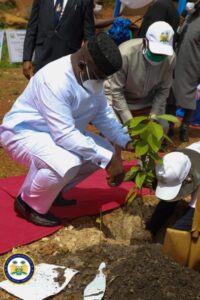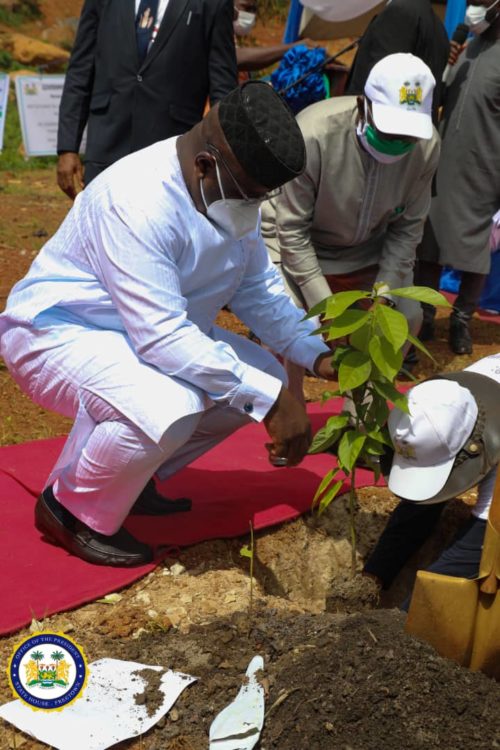By Emma Black
In August 2017, a hillside on the outskirts of Freetown, Sierra Leone’s crowded capital city, collapsed causing a mudslide that killed more than 1,100 people and caused more than $14 million USD in damage. Mustapha Dumbuya, 40, lived in the Juba area very close to the catastrophe. He said, “I saw huge mansions and ‘pan-bodies’ (zinc and stick buildings) on the hill come sliding down. I had neighbours washed away in the rushing waters. I saw the land kicked off the hill by heavy rains and I’m lucky to be alive.”
“There were hundreds of people living in the area and they lost their homes, properties and some lost their lives,” he added. “That was almost the first time I thought about what we were doing to the land. That was the first time I knew about the effect of cutting the trees to build houses and deforestation.”
Dumbuya became an active advocate for tree planting and preserving the Juba area forests. “We need to protect ourselves and our future,” he added. Dumbuya is now a member of a community group called, Skill Pool Sierra Leone (SPSL), who are busy nursing a variety of trees to be replanted along the mudslide path and surrounding hills. The organization was given money through the Freetown City Council (FCC) to develop a seedling nursery and plant trees while teaching community representatives about the need to care for trees. The group planted more than 6,000 trees in 2021-22 and said they will plant another 800 trees in a neighbouring community.

Just after the mudslide, the World Bank did a “Sierra Leone Multi-City Hazard Review and Risk Assessment (Vol. 2): Freetown City Hazard and Risk Assessment”. The report noted, “Nature-based solutions can help mitigate flood, drought, erosion, and landslide (hazards) as well as decrease vulnerability to climate change while creating multiple benefits to the environment and local communities.” In Freetown, the Report said, “There are ongoing low-cost community measures such as tree planting initiatives that will reduce flooding and land sliding.”
The Mayor of Freetown, Yvonne Aki-Sawyerr, who assumed office in May 2018, listed the issues faced by Freetownians. “We experience challenges in the form of deforestation leading to landslides, in the destruction of our coastal mangroves, in the growth of informal settlements with unhealthy living conditions, through breathing polluted air, and in the effects of climate change that we experience through extreme heat, flooding and rising sea levels.”
The FCC Mayor and an imported team of advisors and consultants developed a far-reaching, comprehensive and ambitious program of city development that was launched in January 2019 called, “Transform Freetown”. This guiding document outlined targets from increasing tax revenue to building low-cost housing… from teaching literacy to creating jobs… from decongesting traffic to greening the city – and planting trees.
While in New York for peripheral meetings around the UN General Assembly meeting, on 23 September 2022, the FCC Mayor bragged they had planted 630,000 trees since May 2018 and she predicted they will have planted 800,000 trees by December 2022.
Lyndon Baines Johnson is the Project Coordinator for the Freetown the Tree Town campaign. He clarified that the campaign includes parts of the western area peninsula, which is technically not part of the city of Freetown. He said around the Aberdeen Creek area in the western part of Freetown, they planted 60,000 trees. He added, “We planted trees in some schools, in people’s private compounds, around churches and mosques and even around hospitals that had space.”
Baines Johnson said there were 217 community nurseries in 13 areas who provide seedlings. Then there are community groups who plant the trees and individuals then take pictures and track the trees on a tree tracker app via mobile phone. These people are also supposed to water the trees during the dry season. Each of the “trackers” is paid a monthly salary of Le1,200,000 and Le400,000 per month for transportation (approximately $90 USD). Baines Johnson said some of the trackers have up to 1,000 trees in their portfolios.
Twelve economic and non-economic species of trees (mango, mangrove, teak, neem, moringa, cashew, African wattle, tamarind, cashew and flamboyant) were selected based on biodiversity needs and slope stabilization needs.
The British-based INGO, Environmental Foundation for Africa (EFA), is one of the city’s tree-planting specialists and implementing partners. Vincent Charlie, the Field Manager for EFA, said 550,000 trees have been planted since 2020 and 400,000 more planted during the 2022 rainy season. He said 62 reforestation areas were targeted for planting by 10 community groups and they planted 60,000 mangroves along Aberdeen Creek, a watershed stream and bay area in the western part of Freetown.
Charlie said, “Aberdeen’s population has grown tremendously over the past ten years because of the beach and proximity to downtown Freetown. People have been banking the river and bay area to build homes. When I was a boy, the area behind the golf club, which has been here for more than 60-years, was almost entirely mangrove swamp. But now, people have reclaimed land and cut down the old mangrove growth.”
Schools
A high-profile school tree planting partnership was also announced by the Freetown City Council. According to Baines Johnson of the FCC, more than 30 schools were targeted as places to plant trees. But, the tree planting efforts on school property fell short of success.
Momoh Abdul is a Junior Secondary School teacher and part of the Integrated Science Department of Methodist Girls High School, in Freetown. He said, “On 26 September 2022, FCC trained teachers from 50 schools on how to plant trees and the value of trees.
Abdul grew up in the neighbourhood where he now teaches. He described his childhood, which included “running and climbing through the trees”. He said, “But, as the Mayor identified, so many people moved into the area after the war and continue to encroach on every yard of land, there are hardly any trees left.”
The school compound is a luscious area of bushes and some trees but there is room for more, which is why the FCC wanted to partner with the school. Abdul said, “Twenty trees were planted during a school vacation period when the compound was basically empty. Only four trees remain because the compound cleaners cut the trees while ‘brushing’, the tall grass.”
According to Abdulai A Macarthy, the Principal of Vine Memorial Secondary School, “Ten trees were planted but only five of the trees have survived due to the hard rocky soil.”
Emmile Dumbuya, a JSS3 teacher and head of the Tree Club at Freetown Secondary School for Girls, said, “It was sometime in April 2022, when the FCC tree planting people went to the school and asked for a place to plant the trees. Over 20 trees were planted but only a few started to grow.” He added some of the trees were flooded out during the rainy season and others didn’t grow because they were planted in rocky areas.
A JSS2 teacher, Sahr Jusu, at St Joseph Convent Secondary School said, “Out of the 15 trees planted, only three remain. Most of the trees were cut because we’re building a new structure in the compound.”
Tree planting is known as a simplistic solution to the complex problem of climate change. Many African countries are pushing to address the climate crisis by planting trees including Ethiopia, Zimbabwe and Mauritania. In fact, tree planting has become everybody’s favourite climate response… seen by donors as a worthy tax-payer funded initiative and by governments as cash infusions to stretched budgets. But, it will probably be the next generation or generations unborn who will report whether these tree planting efforts had any affect.
To this day, the brown scar marking the 2017 landslide mars the green hillside of Juba, where Dumbuya and others are planting trees. “We’re making a difference. The trees are making a difference and future generations will be protected from the kind of devastation we saw,” he said. “But, our generation must learn from the disaster, which we caused.”
This report was completed as part of the Centre for Journalism Innovation and Development’s 2022 Climate Change Media Fellowship in West Africa with funding support from the Centre for Investigative Journalism’s Open Climate Reporting Initiative (OCRI).
END –


